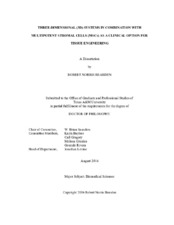| dc.description.abstract | Tissue engineering is a promising treatment strategy for osteochondrosis and osteoarthritis induced articular cartilage injuries, with the goal of restoring structure and function, reducing/eliminating clinical signs, and preventing major surgical treatment. The objective of the work presented herein describes the manipulation of 3D scaffolds and progenitor cells, known as multipotent stromal cells (MSCs), as a potential combination treatment for articular cartilage injuries.
First, a three-dimensional (3D), serum-free collagen system was used as a model to demonstrate the importance of growth factors and cell-matrix interactions in 3D environments. Results demonstrated PDGF-BB induced dose- and time-dependent invasion of MG-63 cells into 3D collagen type I matrices. To examine the specific MT-MMP responsible, siRNA knockdown experiments were performed. Significant reduction of invasion was exhibited in MT1- MMP siRNA cultures, but not MT2- or MT3-MMP siRNAs. This work demonstrates that PDGF-BB is an important growth factor in MG-63 osteosarcoma cell invasion, and that MT1-MMP is required for this process.
Second, canine multipotent stromal cells (cMSCs) were isolated from synovium, marrow, and adipose tissue and comprehensively characterized using a donor-matched study and assays optimized for the canine species. Tissues were isolated from five client owned dogs with cranial cruciate ligament rupture. All tissues produced plastic adherent, spindle shaped cMSCs. Each cell preparation was assessed for MSC criteria using flow cytometry, colony forming unit (CFU) potential, tri-lineage differentiation, and immunomodulation assays. There were significant differences between cMSCs as assessed by growth parameters, CFU potential, tri-lineage differentiation, and immunomodulatory response when comparing donor and tissue source. Synovial and marrow cMSCs exhibited superior short-term osteogenesis while synovium and adipose proliferated more rapidly, displayed higher CFU potential, and formed larger chondrogenic pellets. All cMSCs reduced concentration of murine TNF-in LPS-stimulated mouse macrophage co-culture assays, a novel finding for cMSCs. In summary, as described in humans, significant differences in cMSCs exist due to both tissue source and donor variability.
Lastly, fabrication method for incorporation of cMSCs with polyethylene glycol diacrylate
(PEG-DA) based hydrogels for in vitro and in vivo studies was optimized. PEG-DA hydrogels fabricated with “conventional” photoinitiators were compared to a novel solvent induced phase separation via solvent-casted particulate leaching (SIPS/SCPL) hydrogel system. Using a 21-day time course, marrow cMSCs cultured on SIPS/SCPL-PEG-DA hydrogels exhibited significantly greater attachment, spreading, and proliferation while limiting cytotoxicity when compared to cMSCs photoencapsulated within conventional hydrogels.
Furthermore, using the rat subcutaneous and intra-articular implant models, SIPS/SCPL-PEG-DA hydrogels were biocompatible, as determined by an appropriate vascular, cellular, and fibrous tissue response 21 days post-implantation. In summary, PEG-DA hydrogels fabricated via SIPS/SCPL may be preferential to conventional PEG-DA hydrogels for articular cartilage tissue-engineering scaffolds. Collectively, the work presented herein describes manipulation of 3D scaffolds in combination with cMSCs and represents advancement in the field of canine tissue engineering for focal articular cartilage injuries. | en |


